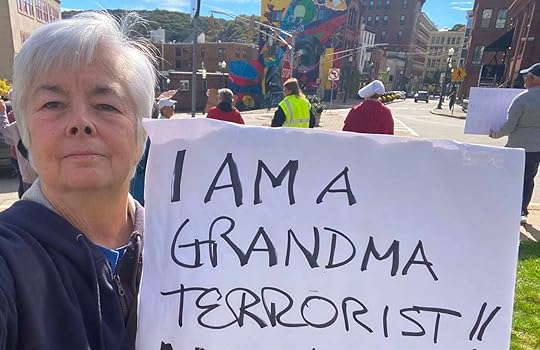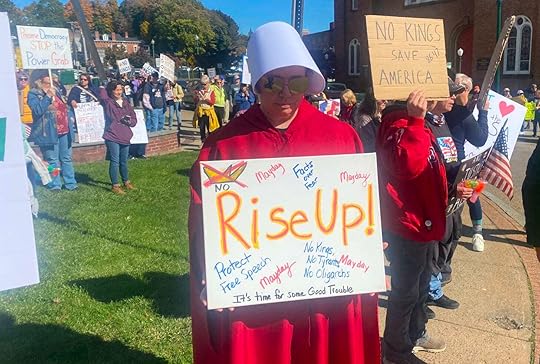Protesting together gives strength, hope
Last week’s No Kings rallies in over 2,600 towns and cities nationwide attracted around 7 million people. Many were motivated to show up because of the stupid things Republican opponents said. Like House Speaker Mike Johnson, who called the gatherings “Hate America Rallies” attracting Marxists and anarchists. And don’t forget Texas Gov. Greg Abbott who ordered the National Guard and state troopers to – what? Patrol? Attend? Escort? -- the protests, which he claimed would be made up of members of antifa.
Subscribe, and I will mow your lawn!
(Raise your hand if you have ever met a member of antifa. I have written about politics for 45 years and I am pretty sure the group is little more than a Fox News fever dream.)
So there I was waving my, “I AM A GRANDMA TERRORIST” sign in front of the ornate city hall of Norwich, Conn., along with about 200 others. It had the atmosphere more of a fall festival than a Marxist celebration.
Yet the people present were clearly worried – about democracy, the state of the country and what President Donald J. Trump was about to do next.
 Self-portrait at the No Kings rally.
Self-portrait at the No Kings rally. What he did the following week, of course, is to tear down a significant portion of the White House to build a 90,000-square-foot obscenity of a ballroom while promising God knows what to wealthy corporate donors. All so they can pony up hundreds of millions to make the “People’s House” look just as hideous and tasteless as Mar-A-Lago. And the next day in a move that was strikingly infantile even for him, Trump posted a mocking video created with AI that showed him in a plane dropping crap on the heads of protesters.
 Fellow terrorist at the Norwich, Conn. protest. Be afraid, be very afraid.
Fellow terrorist at the Norwich, Conn. protest. Be afraid, be very afraid. So here we are. Our country is headed by a completely corrupt president who revels in hatred and delights in division.
It’s why so many protested
Did it make a difference? It may not right away. But it will. And it already made a mark.
The biggest one-day protest in American history was the first Earth Day, April 1, 1970. That’s when 20 million people showed up to protest the fact that corporations were polluting the air, ground and water to make money at the cost of human lives. The U.S. Census, taken once every 10 years, was conducted that very day. It showed the country’s population was 203 million.
So one-tenth of the country showed up on Earth Day.
It mattered.
It turns out the No Kings protests were the second-largest one-day protest in American history. That matters.
There is strength in knowing you are not alone in your worry and outrage. There is solidarity in seeing a crowd of like-minded people who are against sweeps by masked government men who snatch suspected immigrants and act like the Gestapo. There is hope in meeting others who believe that cruelty and hatred should never be national values.
It all matters.
There is hope in meeting others who believe that cruelty and hatred should never be national values.One of the greatest, yet virtually forgotten, protests in American history took place in 1912 in Lawrence, Mass., a multi-ethnic mill town by the Merrimack River. Called the “Bread and Roses” strike (it got that pretty name much later), the strike occurred when factory owners without warning speeded up machines and cut worker pay in response to a state law that weekly hours be cut from 56 to 54. Outraged, 25,000 workers, mostly women and children, walked out. They then organized across dozens of nationalities to fight back.
The strike was gritty and brutal. The governor (also a mill owner) sent the army to the city. Police arrested, injured and killed strikers. Members of the establishment, including the Catholic church, accused strikers of being communists and atheists. Months after the strike they sponsored a “God and Country” parade to shame the strikers and cozy up to the monied classes.
 Strikers facing soldiers with fixed bayonets in 1912
Strikers facing soldiers with fixed bayonets in 1912Yet the 10-week strike changed America. Congressional hearings exposed horrifying factory conditions. The mill owners, knowing a public relations disaster when they saw one, raised pay and slowed down the machines. Child labor laws passed.
I was the editorial page editor at The Eagle-Tribune in Lawrence in 1987, the year the city and the newspaper marked the 75th anniversary of the strike. The workers, to my mind, were heroes. People still lived in Lawrence who walked out of the mills that cold January day. Yet they struggled all those years later with past accusations that they were atheists and anarchists. That undeserved shame was real: Some did not want their names printed in the paper.
 Strikers, including child workers. (Strike photos from Library of Congress).
Strikers, including child workers. (Strike photos from Library of Congress).Despite that, they still changed the world. They had strength in numbers. They saw like-minded people who believed in the same thing they did – common decency.
None of the No Kings protests had to suffer like the Lawrence strikers. Yet I thought of them, because they have inspired me for most of my life, and because they demonstrated the power and strength that lie in numbers. They saw one another, and they knew their cause was righteous. And they persevered.
That’s what was good about Saturday. We saw one another. That’s what we have to hang onto – and keep showing up for. No matter what.
On a very different note; Buffalo State University’s Burchfield-Penney Art Center in Buffalo, NY will host a discussion of my book, “Saving Ellen: A Memoir of Hope and Recovery,” via zoom this Nov. 6, from 6:30 to 7:30 pm, and the public is welcome to join. Here is the information about the event; come one, come all!



